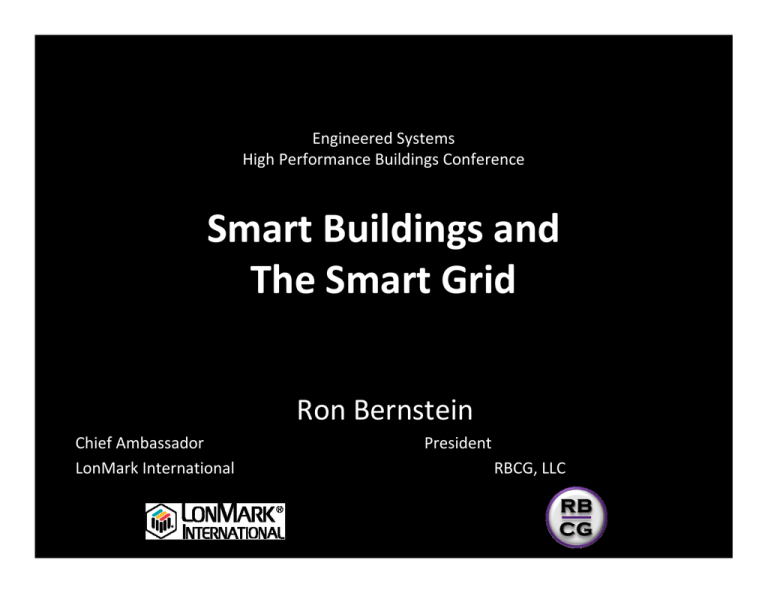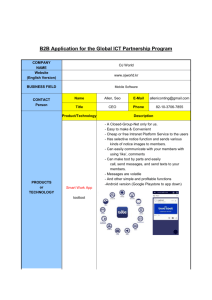Smart Buildings and The Smart Grid Ron Bernstein
advertisement

Engineered Systems High Performance Buildings Conference Smart Buildings and The Smart Grid Ron Bernstein Chief Ambassador LonMark International President RBCG, LLC Smart Building Grid-Aware Building Individual Control Smart Building HVAC Control Grid-Aware Building LonWorks BACnet Lighting Control Data Ops Building Control Stove-piped functions (silos) Multiple front-ends Proprietary Partial integration across silos Multiple open protocols Comms link to Internet Multi-protocol, cross-silo framework for new applications Dynamic load modulation Fine-grained load control Smart Building Concepts • Integration of multiple building systems – HVAC, Lighting, Energy, Emergency/Life Safety • Common platform for data mining and exchange – Using open communications standards – Common infrastructure and data delivery mechanisms • Enterprise data access – IT standards and communication interface • Able to act and react – Internal and external influences • Monitor, Alarm, Schedule, and Manage – Central or remote access – Variety of User Interface Options 3 Building System Integration Remote Monitoring and Control Service Provider Application Interfaces LIGHTING FIRE Indoor/Outdoor: Schedules Occupancy Sensing Functionality checks Detector service Valve Pressure Fire, Life, Safety Appliances Breakdown Maintenance Performance SECURITY Doors PIR Integration Home Electronics Audio Video Computers ACCESS Doors Buildings Occupancy Feed Forward 24/7 Monitoring Service/Maintenance Demand Response Conditioned Monitoring Vehicle Charging ENERGY Appliances Electronics Utility Monitoring (Elec/Water/Gas/Oil) Load Shedding Air/Water Heat Lighting Solar Generation HVAC E G W Air-Handling Unit Boilers Pumps Fans Energy Control Hot Water Heaters Air Quality Smart Buildings Elements System Integration and Access • Sharing data from sensors – Occupancy sensor data used by HVAC, Lighting, and Security • Monitor and effect energy consumption – Used by demand limiting control strategy – Real time adjustments via control system • Who’s in control – Direct occupant control over environment – Facility staff control – Subsystem dependent - Lighting, HVAC, Security • Alarm management – Single alarm, multiple recipients – Remote acknowledgement and response – Preventative maintenance based upon actual usage 6 Smart Grid Concepts • Incorporates all aspects of the power grid – Energy generation, distribution, and consumption • Ability to act and re-act to changing conditions – Weather variables, production costs, delivery price • Supply and demand management – Communication from supply to demand – Control and monitoring of usage levels – Proactive and reactive management • Electrical Grid Management – – – – Demand Response Load Shedding Load Shaping Response time in minutes (not days) Demand-Side Communication Technology Needs Figure Source: NIST Framework and Roadmap for Smart Grid Interoperability Standards, v1.0 8 Open Innovation within the Smart Grid - Economics - Carbon - Efficient Operation - Lowered Prices - Wholesale and retail integration - Automation - Reliability - Effectiveness - Cost - Choice 9 The Common Elements: Access to Data and Communication Layer Stakeholder Data level Data Types Examples Enterprise Owner/Master integrator/Facility Staff/Application Developer/Aggregator 5, 6 - Aggregate, Monitor, Report Energy savings, pricing, reporting/monitoring, scheduling Campus/ District Owner/Master integrator/Facility Staff/Application Developer/Aggregator 4, 5 - Schedule, Report, Monitor Alarms, Monitoring, Scheduling, Energy Data, Premises/ System Owner/Integrator/Facility Staff/Application Developer 3, 4 - DR, Load shed, control, monitor, schedule Energy mode, ADR Signals, Alarming, Scheduling Zone User/Occupant/ Manufacturer/Vendors/ Integrators 2, 3 Status/Mode/Scene, schedule Occupied mode, Load Shed mode, Lighting scene Room User/Occupant/ Manufacturer/Vendors/ Integrators 2 – Status Mode Scene Occupied mode, Load Shed mode, Lighting scene Device Manufacturer/Vendors Integrators 1 - on/off/control, low level data Temp, pressure, status, set points, mode, scene Control Networking Platform For Smart Buildings Enterprise Applications PC, MAC, Android, iPhone Any IP network Building to enterprise Interface: protocol neutral Building to enterprise Interface: protocol neutral Building to enterprise Interface: protocol neutral Smart Homes Building to enterprise Interface: protocol neutral Smart Branches Smart Buildings Smart Campuses Subsystem Intelligence Smart Everything Smart Grid – Enterprise Applications Any /IP network Smart Elevators Smart Access Control Smart Lighting Smart Metering Smart Grid Smart Buildings Smart Renewables Standards-based Communication Common Data Models Enterprise Applications PC, MAC, Android, iPhone IP Any IP network IP/852 Modbus M-bus LonWorks® BACnet/IP DALi® EnOcean® Zigbee® SOAP/XML Modbus M-bus LonWorks® Other… IP-852 BACnet/IP ISO/IEC14908 Smart Buildings Smart Branches Smart Buildings Smart Campuses Platform Example in Smart Building Need: Open at every level – From System to Device Enterprise Applications Energy Analytics Energy Asset Management Automatic Demand Response Peak Day Pricing Facility Management Any TCP/IP AnyNetwork IP network Local IT Network Subsystem Interfaces Device Level Network LonWorks BACnet Modbus, KNX DALI, M-bus EnOcean Common App Model Mix and match best-in-class subsystems – one App interface App 2 … App n SOAP/XML Enterprise Common Profile Model Subsystem Driver Level Interface LonWork s DALI Modbus BACnet, Zigbee Field Level Network Integrate LonWorks, BACnet, DALI, Zigbee, Modbus systems across IP Define common App interface using LMI Profile model Enable App independence from control network Multiple device networks – LonWorks, Modbus, M-bus Co-develop by LonMark, ASHRAE, DALI, Zigbee, TC-247, ??? Enterprise Local IT Network Network App 1 OpenLNS Device Network BACnet Sub-System Zigbee Sub-System Enterprise Application Standard Interface Users Analytics App Reporting App O&M App Alarming App Common Profile Model XML/SOAP Data Server Appliance LonWorks System Web Service Data Server Appliance Modbus System EnOcean System Data Server Appliance BACnet Sub-System DALI System Zigbee Sub-System KNX System Top Down - User Perspective • User allowed to pick and choose Apps based on need, not bells and whistles – Solution is more open, less bundled • Easier to specify multi-tier integrated solutions – App providers have common interface model to build to – Lower the cost for Apps • Increases flexibility for integrators, installers • Enable Demand Response type applications – OpenADR and LonMark Profile combined into one interface • Better scalability and interaction across subsystems EASI: Enterprise App Standard Interface • CEN/LONMARK/BACnet/ASHRAE Joint Working Group • Enable App developers to work with any sub-system • Protocol neutral networks interface to host Apps – Application independent interface model – co-developed – Scalable solutions for any application • Support new interface and driver products from multiple suppliers – Sub-system level drivers/interfaces – implementing in local data servers – Common data modeling – Web Services using SOAP/XML – Potential for network management tools for managing multiple protocols in one tool environment Building and Grid Challenges • Dealing with generation capacity shortages • Managing lower capacity margins • Reducing the number and intensity of peak consumption hours • Balancing the wholesale and retail price of electricity • Increasing energy savings through energy efficiency • Managing building automation and response time and levels Open Automated Demand Response OpenADR is an information exchange model to facilitate communication of price and reliability signals. Signaling- continuous, 2-way, secure messaging for dynamic prices, emergency and reliability signals. Client-server architecture - uses open interfaces for interoperability with publish and subscribe systems Hardware retrofit or embedded software many clients fully implemented with existing XML software Example Example of of Pricing Pricing Data Model Data Model Physical Physical Communications Communications Control Control Strategies Strategies OpenADR Architecture Alt Communication Customer Customer Customer Group Commercial Commercial and and Industrial Industrial Customer Group Residential, Residential, Small Small Commercial Commercial Ancillary Services and Renewable Integration Daily Peak Load Management Ramp Smoothing Shift Load to Night - Regulation Down 22 11:00 PM 10:00 PM 9:00 PM 8:00 PM 7:00 PM 6:00 PM 10000 5:00 PM CPP Baseline 4:00 PM 3:00 PM 2:00 PM 1:00 PM 12:00 PM 11:00 AM 10:00 AM 9:00 AM 8:00 AM 7:00 AM 6:00 AM 5:00 AM 4:00 AM 3:00 AM 2:00 AM 1:00 AM 12:00 AM Whole Building Power (kW) Evidence of AutoDR in Action 12000 CPP MA Baseline OAT Baseline 8000 6000 4000 2000 0 23 OpenADR Results OpenADR Application Impacts PG&E Demand Bid Test Day (all participants) 24 Continuous Energy Management 25 Market Drivers • • • • • Allows DR resource ready for dispatch. Improves DR reliability, predictability, value, etc. Simplifies and reduces cost of DR Creates interoperability among customer systems Increases customer participation, reduce labor of manual price response • Allows customer to choose level of response and how to enable a DR and energy strategy • Allows ability to embed automation in customer’s control system Commercial Building DR Actions 27 DR Rules Application Engine Example New LONMARK Profile Demand Response Rules App DR Server Message DR Client LonMark Profile LonMark Profile Event Utility ADR signal Building Response HVAC Response Lighting Response Stage 0 DR Level 1 Nothing HVAC_Mode 1 SCENE_1 Nothing Stage 1 DR Level 2 Minimal HVAC_Mode 2 SCENE_2 Notify facility manager - email Stage 1 DR Level 3 Minimal HVAC_Mode 2 SCENE_2 Notifiy facility manager, supervisor Stage 2 DR Level 4 First Level HVAC_Mode 3 SCENE_3 Stage 2 DR Level 5 First Level HVAC_Mode 3 SCENE_3 Stage 2 DR Level 6 Second Level HVAC_Mode 4 SCENE_4 Stage 3 DR Level 7 Second Level HVAC_Mode 4 SCENE_4 Stage 3 DR Level 8 Maximum HVAC_Mode 5 SCENE_5 Stage 3 DR Level 9 Maximum HVAC_Mode 5 SCENE_5 Shut Down (go home) HVAC_Mode Off SCENE_OFF Critical Alert DR Level 10 Notification Notify facility manager, CFO Notify CEO - all - confirm action Notify all - confirm action LonMark and OpenADR Update • LonMark and OpenADR Liaison Agreement – Enable seamless interoperability • LonMark Smart Grid Profiles – Energy Metering, Solar, Geothermal – Building DR Management • OpenADR Alliance certifying products for compliance with standard – Standard published by OASIS – Pursuing international standardization through IEC PC118 Summary • Facilities are and will continue to be multi-platform, multi-protocol, multi system • Communication and data standards is critical • New applications, new platforms, common data • Communication at the building to the grid is mandatory – NIST taking leadership role – LonMark, BACnet, Zigbee, OpenADR and others working together • Find ways to make integration simpler • Encourage participation – Join committee, enable voice Questions? Ron Bernstein www.lonmark.org ron@lonmark.org www.rb-cg.com ron@rb-cg.com



